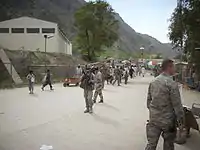Afghan Border Force
The Afghan Border Police (ABP) secure Afghanistan's 5,529 kilometres (3,436 mi) border with neighboring countries and all its international airports. It also administers immigration services such as checking documents of foreigners entering the country or deporting them.[1] The ABP's anti-narcotic efforts are a prominent concern to the international community at present. The ABP and other divisions of the Afghan National Police jointly patrol a 55 km-wide corridor along the entirety of Afghanistan's border, particularly the longest and porous Durand Line border in the southeast with neighboring Pakistan.

Organization
The ABP falls under the command of the Afghan National Police (ANP) which is under the administrative control of the Ministry of Interior Affairs. The ABP is headquartered in Kabul, in the nation's capital, and is commanded by a Lieutenant General. The Afghan Border Police divides command of its 23,000 Members across 6 zones to protect 14 Border Crossing Points and 5 Major Airports.
Mazar-e-Sharif (Northern Zone)


Fayzabad (Northeastern Zone)
Jalalabad (Eastern Zone)


Gardez (Southeastern Zone)


Kandahar (Southern Zone)


Herat (Western Zone)

Majority of the Afghan Border Police officers are trained by the United States Armed Forces and various Federal government employees as well as by the European Union Police Mission (EUPOL). In order to prepare for their duties as ABP, recruits attend an 8-week course designed by the German Bundespolizei (BPOL). Also Italy provides qualified training to ABP personnel in West Region by TF GRIFO deployed in Herat by the Guardia di Finanza. The BPOL are still heavily involved in mentoring ABP officers as of 2009.[2]
As of January 2011, there are at least 25 U.S. Immigration and Customs Enforcement and Customs and Border Protection officers providing training to the Afghan Border Police. Homeland Security Secretary Janet Napolitano stated that the number could reach 65 or more by the end of 2011. Napolitano visited the Torkham border crossing with Pakistan and was satisfied with the progress being made there.[3][4]
The ABP was known to have jointly trained with the Tajik Border Troops, its equivalent in Tajikistan, which was overseen by the Organization for Security and Co-operation in Europe.[5]
References
- 35 illegal Pakistanis deported from Nangarhar Archived April 11, 2015, at the Wayback Machine, by Abdul Mueed Hashimi for Pajhwok Afghan News. September 24, 2012.
- "Germany to send 1,200 police to Afghanistan", The Local, Berlin, 10 Oct 2009, archived from the original on 13 October 2009, retrieved 2009-10-25
- "US to bolster Afghan border, customs training". MSNBC. Archived from the original on 2011-01-06. Retrieved 2011-01-13.
- Starr, Penny (January 4, 2011). "Obama Is Sending Border Officers from DHS--Which Has Failed to Secure U.S.-Mexico Border--to Help Secure Afghan-Pakistan Border". Cybercast News Service. Archived from the original on January 7, 2011. Retrieved 2011-01-13.
- Stojkovsky, Goran (November 28, 2012). "Tajik and Afghan border guards complete training". OSCE. Retrieved 2013-09-26.
External links
| Wikimedia Commons has media related to Afghan Border Police. |